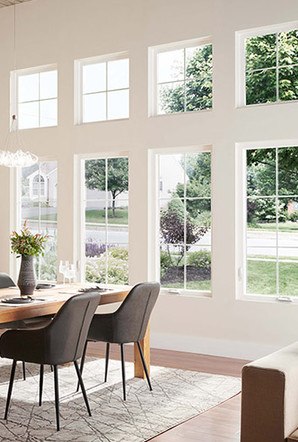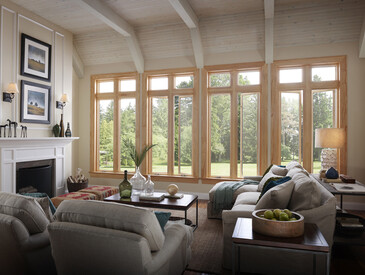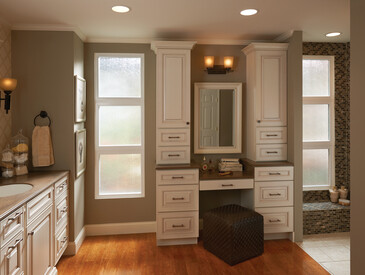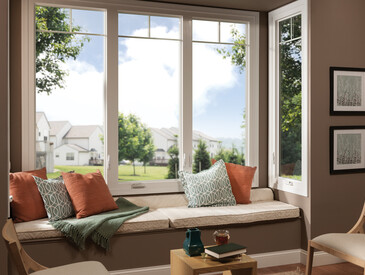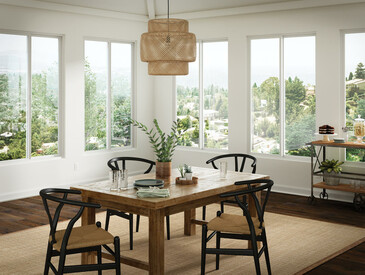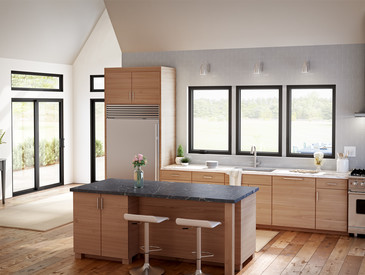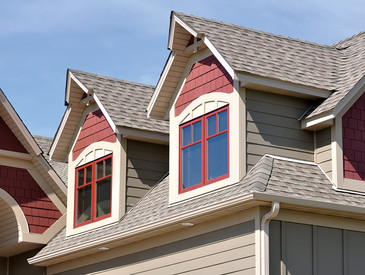When you hear the words “French door,” what comes to mind? You probably think of a sunlit patio, breezy balcony, or cozy courtyard where you can read a book or enjoy a glass of wine. The door itself is probably a classic, wood door, painted white, with large glass panes separated with a white grid. You’d be right – but today, French doors come in many styles and serve many purposes. Let’s dive into this popular door style.
What Are French Doors?

French doors have a distinctive design that consists of a frame around one or more glass panels that extend the full length of the door and are divided by a grid. Traditional French doors are wood, but today their frames can be vinyl, aluminum, or even fiberglass. They’re typically constructed as a pair of doors that open from the center, enhancing natural light and visual connectivity between spaces.
Interior French Doors

Interior French doors connect two interior spaces, providing privacy and noise reduction between different areas without sacrificing the openness and light that make spaces feel larger and more inviting. Whether you connect a kitchen to a formal dining room, a hallway to a library, or a den to a living room, interior French doors are ideal for creating a sense of openness and continuity between rooms. You can even use French closet doors in your bedroom for a touch of sophistication.
Exterior French Doors

Exterior French doors serve as an elegant transition between the indoors and outdoors. They’re more robust than interior French doors, with weatherproofing, energy efficiency, and security features to help ensure safety and insulation. French patio doors connecting an interior space to a patio, deck, or garden can extend your living space, offer panoramic views, boost natural light, and enhance the indoor-outdoor flow of your home for entertaining and personal enjoyment.
French Sliding Doors

French sliding doors combine the classic look of traditional French doors, with the functionality and space-saving design of sliding glass doors. Like regular sliding doors, they move along a track to open and close. Their distinctive "French" character comes from design details such as window grids and the use of hardware such as handles and hinges that mimic the style of French doors.
The Benefits of French Doors
A French door is more than just an entry or exit point. It’s an elegant way to allow natural light to fill your home and create a seamless indoor-outdoor space. Here are just a few of the benefits of French doors.
Aesthetically Beautiful
Let’s start with how beautiful they are. Whether your home is traditional, modern, rustic, or shabby chic, French doors can work in your space. The difference between a standard patio door and a French door is the thickness of the lower rail. It’s generally wider than the top and sides, which gives it a distinct look. The beauty comes from the proportions and symmetry.
Natural Light
The French first developed this door style in the 17th century to allow more light into dimly lit homes. They developed these doors much like a window, so the glass extends for most of the door’s length. Today’s glass French doors come in many styles: There are French inswing, French outswing and French sliding door styles to maximize your natural light and breeze. Plus, you can use additional glass panels called sidelites for even more natural light or airflow.
Energy Efficiency
Another wonderful aspect about modern glass French doors is their energy efficiency. Most will be manufactured with dual-pane glass suitable for every climate, and additional glazing can be added to help prevent additional heat or cooling loss in climates that get very hot or cold. Older doors can be leaky and inefficient, and it’s smart to replace sliding glass doors with newer models to improve energy efficiency.
Indoor-Outdoor Living
Finally, French patio doors can help you embrace indoor-outdoor living. Does your family tend to gather in the kitchen? Adding an expansive patio door to that room can offer additional space to entertain. From summer gatherings to special occasions, a French patio door can add a special touch to your home’s décor. Take a look at all the options available and let it be a reflection of your unique style.
Are French Doors Right for Your Home?
French doors add a look of classic sophistication to any home. The main things to consider are the size door you need and the potential costs of installation.
French Door Sizes
Modern French doors come in a variety of styles and sizes. The standard height for French doors is 80 inches, but 96-inch doors are also available for taller openings. Standard French door sizes range from 30 inches to 72 inches wide per door. They’re usually installed as a pair, doubling the total opening to between 60 inches and 144 inches. Today, single French doors are also available for smaller spaces, however, if you have a very small space, you might consider a pocket door or another style instead of a French door.
Cost of French Doors
The cost of French doors varies significantly based on material, design, and customization, ranging from $300 to $5,000 per unit. Installation adds $300 to $1,000 to the total expense. Factors such as material quality, energy-efficient features, and custom designs influence the price. Considering both the upfront cost and potential long-term benefits like energy savings can help in making a cost-effective choice.
Explore French Doors and More
Modern French doors go beyond double, swing-out styles and can be modified for a variety of spaces, architectural styles, and personal preferences. From classic vinyl French patio doors to durable fiberglass, homeowners have more options than ever before to get that classic, elegant look. MILGARD has been making top-quality French patio doors and more for decades, and we stand by our products with an industry-leading warranty. Browse our wide selection of patio doors to get started building your perfect French door. Or connect with a local dealer who can walk you through the process. We’re always happy to help.













